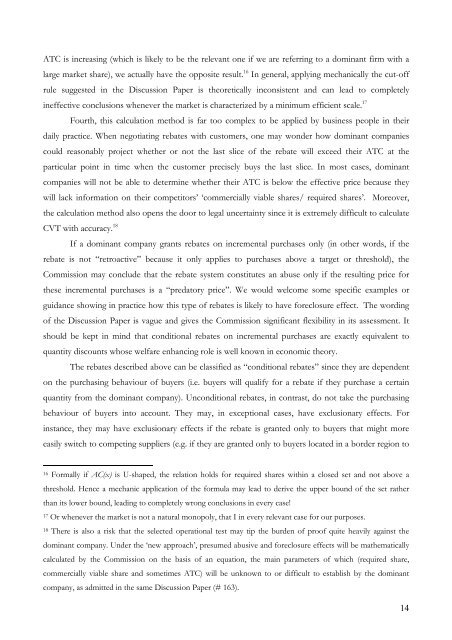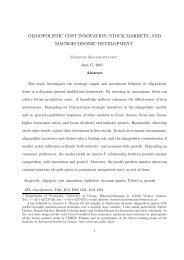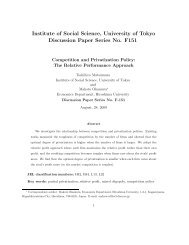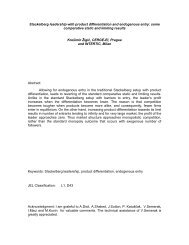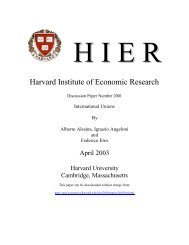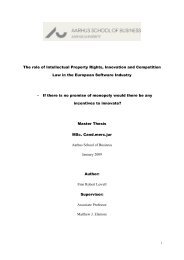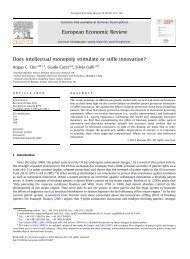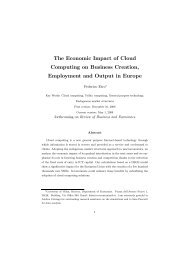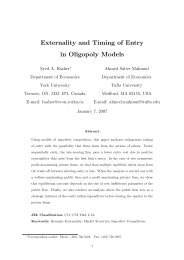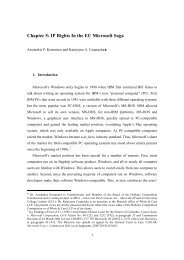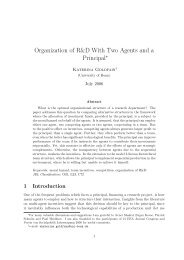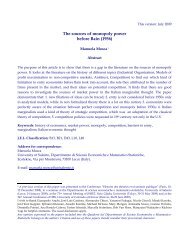The EU Approach to Abuse of Dominance - Intertic
The EU Approach to Abuse of Dominance - Intertic
The EU Approach to Abuse of Dominance - Intertic
Create successful ePaper yourself
Turn your PDF publications into a flip-book with our unique Google optimized e-Paper software.
ATC is increasing (which is likely <strong>to</strong> be the relevant one if we are referring <strong>to</strong> a dominant firm with a<br />
large market share), we actually have the opposite result. 16 In general, applying mechanically the cut-<strong>of</strong>f<br />
rule suggested in the Discussion Paper is theoretically inconsistent and can lead <strong>to</strong> completely<br />
ineffective conclusions whenever the market is characterized by a minimum efficient scale. 17<br />
Fourth, this calculation method is far <strong>to</strong>o complex <strong>to</strong> be applied by business people in their<br />
daily practice. When negotiating rebates with cus<strong>to</strong>mers, one may wonder how dominant companies<br />
could reasonably project whether or not the last slice <strong>of</strong> the rebate will exceed their ATC at the<br />
particular point in time when the cus<strong>to</strong>mer precisely buys the last slice. In most cases, dominant<br />
companies will not be able <strong>to</strong> determine whether their ATC is below the effective price because they<br />
will lack information on their competi<strong>to</strong>rs’ ‘commercially viable shares/ required shares’. Moreover,<br />
the calculation method also opens the door <strong>to</strong> legal uncertainty since it is extremely difficult <strong>to</strong> calculate<br />
CVT with accuracy. 18<br />
If a dominant company grants rebates on incremental purchases only (in other words, if the<br />
rebate is not “retroactive” because it only applies <strong>to</strong> purchases above a target or threshold), the<br />
Commission may conclude that the rebate system constitutes an abuse only if the resulting price for<br />
these incremental purchases is a “preda<strong>to</strong>ry price”. We would welcome some specific examples or<br />
guidance showing in practice how this type <strong>of</strong> rebates is likely <strong>to</strong> have foreclosure effect. <strong>The</strong> wording<br />
<strong>of</strong> the Discussion Paper is vague and gives the Commission significant flexibility in its assessment. It<br />
should be kept in mind that conditional rebates on incremental purchases are exactly equivalent <strong>to</strong><br />
quantity discounts whose welfare enhancing role is well known in economic theory.<br />
<strong>The</strong> rebates described above can be classified as “conditional rebates” since they are dependent<br />
on the purchasing behaviour <strong>of</strong> buyers (i.e. buyers will qualify for a rebate if they purchase a certain<br />
quantity from the dominant company). Unconditional rebates, in contrast, do not take the purchasing<br />
behaviour <strong>of</strong> buyers in<strong>to</strong> account. <strong>The</strong>y may, in exceptional cases, have exclusionary effects. For<br />
instance, they may have exclusionary effects if the rebate is granted only <strong>to</strong> buyers that might more<br />
easily switch <strong>to</strong> competing suppliers (e.g. if they are granted only <strong>to</strong> buyers located in a border region <strong>to</strong><br />
16 Formally if AC(x) is U-shaped, the relation holds for required shares within a closed set and not above a<br />
threshold. Hence a mechanic application <strong>of</strong> the formula may lead <strong>to</strong> derive the upper bound <strong>of</strong> the set rather<br />
than its lower bound, leading <strong>to</strong> completely wrong conclusions in every case!<br />
17 Or whenever the market is not a natural monopoly, that I in every relevant case for our purposes.<br />
18 <strong>The</strong>re is also a risk that the selected operational test may tip the burden <strong>of</strong> pro<strong>of</strong> quite heavily against the<br />
dominant company. Under the ‘new approach’, presumed abusive and foreclosure effects will be mathematically<br />
calculated by the Commission on the basis <strong>of</strong> an equation, the main parameters <strong>of</strong> which (required share,<br />
commercially viable share and sometimes ATC) will be unknown <strong>to</strong> or difficult <strong>to</strong> establish by the dominant<br />
company, as admitted in the same Discussion Paper (# 163).<br />
14


